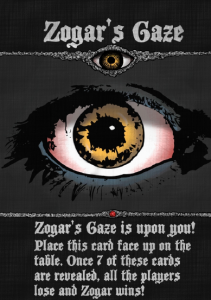Hail traveler. We wish you rest and health from your journey and have rooms in the back. Your hulking sword and fancy garb tell me that you’re aren’t selling wares, though. Yeah, we’ve been getting a lot of adventurers like yourself in from the Old Road of late. So, here’s the same story I’ve given the others. And don’t ask me to repeat it. I hate that.
Alright, so one day a while back – no one seems to agree when – this guy shows up and starts being a jerk for no reason. A major jerk. This guy doesn’t just cut you in line. He cuts you in line and then burns the store down. That kind of jerk. Anyway, he starts acting like he owns the place. And, now, he sorta does. Calls himself Zogar.
He’s got a tower up in the mountains, about a half day’s walk north of here. It’ll be easy to find; he doesn’t really do subtle. Don’t suppose he needs to. Many adventurers have tried to take him out sonny. You aren’t the first one to come bounding along looking for whatever he has stashed up there.
Don’t get me wrong: I truly hope you succeed at kicking him where it hurts, and if you do, don’t forget about us here at The Dragon’s Tale. But in that teeny tiny chance that ol’ Zogar does you in, I’m going to have to ask for the money up front. You understand, right?
The Premise
The evil Zogar’s influence has taken root and is slowly corrupting the land. Players make up a handful of brave adventurers who have decided to venture into his dungeon in the hopes of securing valuable treasures and facing down Zogar first – before he sets his sights upon you.
The Rules
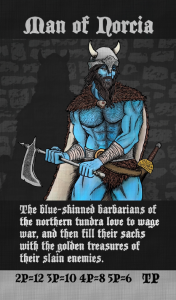
Blue skinned, hot blooded.
The dungeon-diving adventure of Zogar’s Gaze is primarily through a central Dungeon deck and requires no setup. To begin, each player is randomly assigned a pair of Class and Race cards. These are the player’s secret objectives for the game. Race cards task the player with acquiring points of one or more types, while Classes have players looking for a specific item.
The starting player is determined randomly.
Turns in Zogar’s Gaze are broken down into a few short steps. First, the active player may purchase a Market card by shuffling five points worth of cards from their hand back into the deck. Then players proceed to Dungeon Delving. Before they enter the dungeon, however, they must decide which items to take with them. Items purchased or found in the dungeon can be useful for overcoming challenges and monsters.
Dungeon Delving is done via the Dungeon deck. It’s comprised of both positive encounters, such as finding items, treasures, and quest materials, and negative encounters, such as traps and monsters. Dungeon cards also have a Level rating from One to Three, with higher Levels denoting higher risks and rewards. The Dungeon deck is cut and the top card revealed. Unless it is a trap, monster, or Zogar’s Gaze card, the player takes it. Generally, unless they have encountered a monster, the player chooses to continue into the dungeon or leave. If a player leaves, they keep any items they acquired this turn and end their turn. Zogar’s Gaze cards are removed from the deck, signaling his attention slowly being turned towards you.
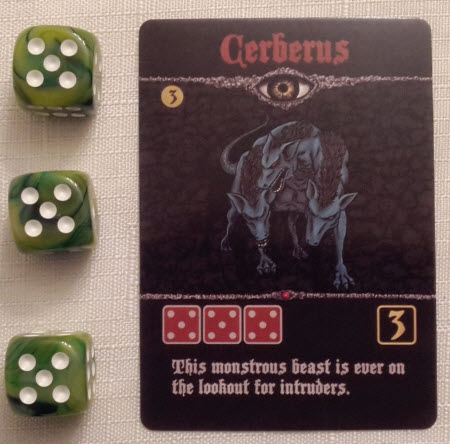
Correct dice results means successful combat.
A player must face any monster revealed. If a player possesses an item matching an element on the monster card, it is automatically defeated. Otherwise, monster encounters in Zogar’s Gaze are handled by rolling a series of six-sided dice, trying to either match the pattern shown on the cards (such as three 4s) or one more of that pattern (four 5’s instead of three 4s). Dice can be re-rolled up to twice.
If a player meets the monster’s displayed dice results, they defeat it. They take the card, and end their turn. If they did not, the player dies, losing all items currently with them.
Turns continue until either seven Zogar’s Gaze cards are revealed or one player successfully accomplishes both of their objectives. At Seven Zogar’s Gaze cards, players have caught Zogar’s ire, and everyone loses. Alternatively, the first player to reveal both objectives wins. That player will be hailed for all time as the one who drove Zogar from the land, and they will live a life of moderate fame.
Everyone else will fade into penniless obscurity.
The Book of +5 Fondness
Nostalgia is a powerful thing. As a rule, people like progressing forward, but many can’t help but to look back at older versions of something that served them well, even if newer iterations are clearly better. Take the automobile, for instance. The modern car has tons of innovations that its predecessors lacked. There was a time before cars had airbags, or seat belts. At one point, car makers actually had to invent windshield wipers, and before that, windshields themselves. There is little doubt that the cars of today are some of the safest, most efficient vehicles to date, and yet people still view many older models quite fondly. That’s nostalgia. For many, a car isn’t just a tool or a possession, but an expression of who that person is and the experiences they’ve had.
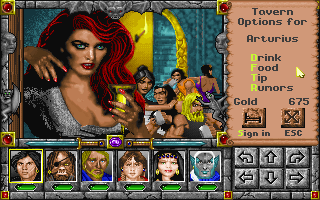
Welcome, travelers.
Such is the case with the look of Zogar’s Gaze. To those unfamiliar with the art style’s heritage, its simple colors and basic illustrations could seem unfinished or rushed. Compared to today’s modern fantasy artists, you’d be right. Yet the entire art style of the game is done quite deliberately.
Zogar’s Gaze is reflecting artwork of the early days of Dungeons & Dragons – the first ultimate dungeon crawler. All of the items, heroes, and monsters of this game serve as a callback, either for those who grew up the with those tabletop books, or early computer RPGs adaptations, like the Might & Magic series.
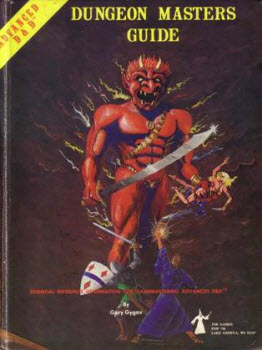 Zogar’s Gaze nostalgia-laden art is its greatest attribute. It pairs classical artwork with the iconic theme of a dungeon dive, and they play off one another quite well here. It has an evocative flavor that harkens players back to a time in the gaming world when rules of adventuring were still being written and dungeons saw unexpected character deaths around every corner.
Zogar’s Gaze nostalgia-laden art is its greatest attribute. It pairs classical artwork with the iconic theme of a dungeon dive, and they play off one another quite well here. It has an evocative flavor that harkens players back to a time in the gaming world when rules of adventuring were still being written and dungeons saw unexpected character deaths around every corner.
For Immersionists born before 1990, or those who can appreciate a nice homage, Zogar’s Gaze will be appreciated. On the other hand, if they’re seeking character development, they’ll find that their princess is in another castle.
Pitfalls and Pit Traps
For what is effectively a card-based Press Your Luck game, you shouldn’t go in to Zogar’s Gaze expecting a lot of gameplay depth. There isn’t. Press your luck games are designed to be quick and chaotic affairs, with players trying to determine when to double down on their next move and when to play it safe. The idea is that the longer you continue, the higher your risks and rewards stack. Unfortunately, while Zogar’s Gaze attempts to follow this pattern, the results prove to be uneven in three key areas.
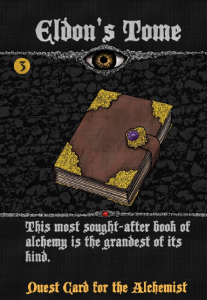
No Tome, no chance for
The Alchemist.
Firstly, there’s the entire aspect of, well, winning. Of the two objectives, the Race card is manageable and straightforward: the Man of Celdor wants Fame Points, so he wants to kill monsters, and the Mermaiden wants Artifact Points, so she’s after finding cards that supply AP. The Class cards, though, are often an exercise in futility. Every Class but one requires a specific card that you need to find – and hold on to – until the end of the game.
The thing is, there is exactly one copy of each of them – in a deck of 141 cards. The Cleric class has it slightly easier than the rest, as they must defeat a Wraith; there’s a whopping three of those. You are much more likely to reveal too many Zogar’s Gaze cards and lose.
In attempting to prevent that, you find yourself digging through cards until you are forced to stop. Because you’re after the proverbial needle in a haystack, you rarely opt to simply leave the dungeon on your own accord unless you’ve found what you’re after. With such odds against you to find your quest item, your turn will conclude by fighting a monster, or dying trying. Instead of it being a press your luck situation where you’re risking for bigger and better things, instead you’re gambling to try to minimize negative things. Like losing.

Enjoy forty Skip Cards in a row!
Secondly, not all cards are created equal. The Market cards, for example, are very situational, and players can find themselves not wanting to buy the ones revealed, but they also don’t want to risk a blind purchase. The result is an underutilized Market, which is unfortunate. Don’t be surprised if players buy Market cards just to empty their hand, which seems antithetical to the Market deck’s premise of buying things you want.
The bigger issue, though, is trap cards. Well, one trap in particular: the Pit Trap. This card not only ends a player’s turn, but each subsequent turn they must roll a four-of-a-kind to escape or skip their turn. It’s a great nod to some of the more insidious traps of early dungeon crawls, but in practice it can sideline a player for most of the game, making for a very frustrating experience. They are so unfun, in fact, that we actually recommend removing Pit Traps from the game. They are that bad, and they won’t be missed.
Lastly, there’s the combat system. Conceptually, the dice-matching system in Zogar’s Gaze is simple and easy to understand. If a monster requires three 2s to be defeated, it visually conveys to the player what’s needed to succeed. In theory, it’s a great little randomized process so dice games can have different goals to strive for. In reality, it becomes rather tedious, because the probability doesn’t change. For example, the Level 2 monster ‘The Beast’ requires a 4-5-6, whereas the Level 3 monster ‘Cerberus’ requires three 5s. Yet the chances of attaining those results are statistically the same (3.22% before rerolls). As is often the case, the matching system looks nice, but players quickly lose enthusiasm with it.
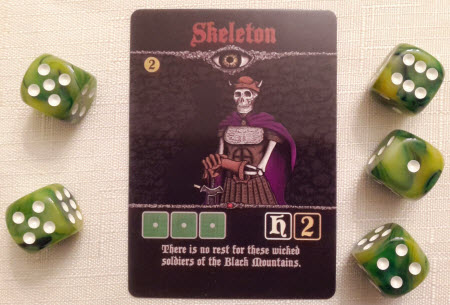
The bad news? You lost. The worse news? You’re dead. The good news? Combat is over.
The Call For Adventurers
Daredevils will appreciate the high degree of gambling involved in Zogar’s Gaze, but most other archetypes will be far less amused. Tacticians don’t like the inability to plan in these styles of game, and that’s no different here. Similarly, there isn’t enough exploration or item acquisition to attract the attention of Architects. Moreover, Socializers generally like games with simple rules and short turns, which Zogar’s Gaze has. However, with little player interaction and seemingly repetitive turns, they may quickly lose interest.
Strikers are the wild card when it comes to Zogar’s Gaze. The goal is very straightforward, which this group fully appreciates. However, getting to that goal is like walking through a labyrinthine haze: you can see the exit, but you’re not sure if you’ll ever get there. There is a high degree of random chance in Zogar’s Gaze, and that lack of control may likely turn many Strikers off after a session or two.
The Takeaway
Old Gygaxian tabletop dungeons were well known to be death traps, full of sudden and meaningless ends for many unfortunate players. But that early anxiety of never quite knowing what came next is part of what endeared so many people to the roleplaying genre. Zogar’s Gaze does a remarkable job at evoking that feeling of the dungeon days of yore between its classical fantasy setting and artwork.
But just like those early tabletops, it also stumbles in many areas. Zogar’s Gaze is incredibly swingy and unpredictable, and yet paradoxically, the combat system becomes rather repetitive. Players can spend whole turns rolling dice with little emotional investment, hoping that they luck into the single card they need. And that’s a problem. Zogar’s Gaze has the aesthetic of a great dungeon crawling adventure, and for that it should be praised. That said, it could benefit from less punishment and more incentives, and it ultimately has trouble living up to its own source material.
Zogar’s Gaze is a product of Grey Gnome Games.
Cardboard Republic Snapshot Scoring (Based on scale of 5):
Artwork: 4
Rules Clarity: 4
Replay Value: 1.5
Physical Quality: 4
Overall Score: 2
Photo Credits: Xeen Tavern by MyAbandonWare; AD&D Manual by Goodreads; Uno card byWikimedia.

